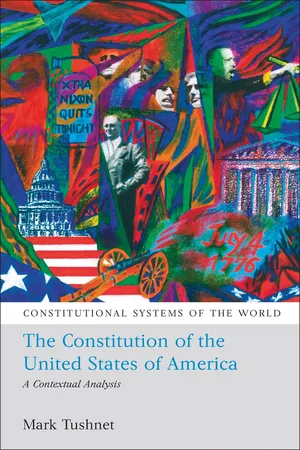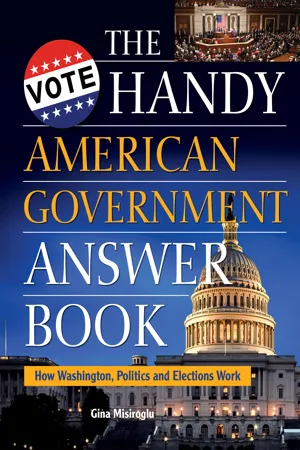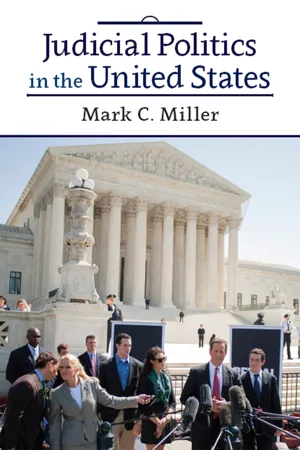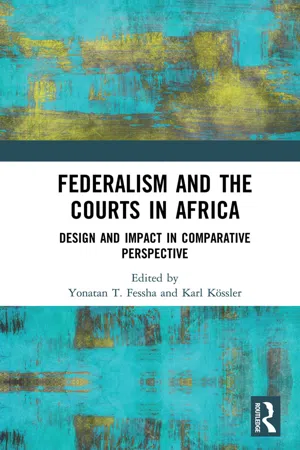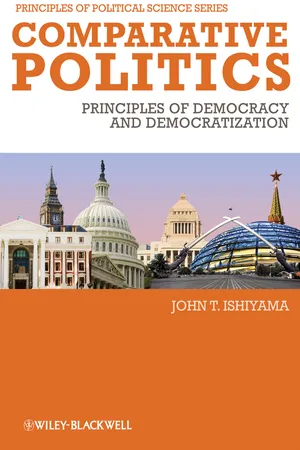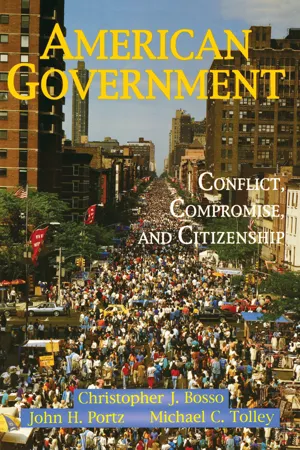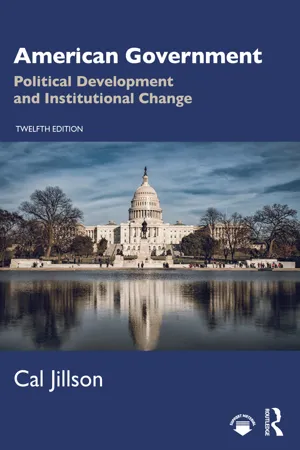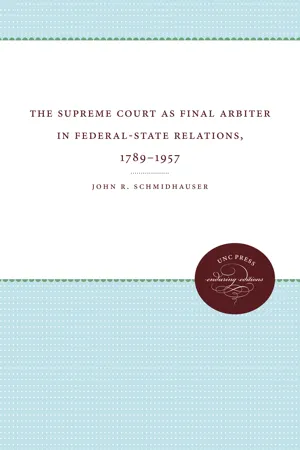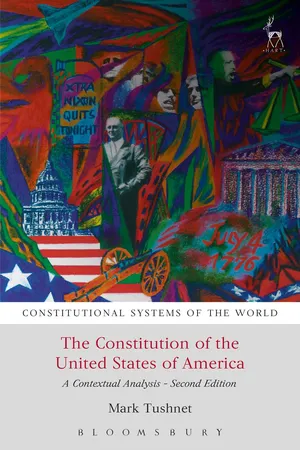Politics & International Relations
Federal Court System
The Federal Court System is the judicial branch of the United States government, consisting of the Supreme Court, Courts of Appeals, and District Courts. It has the authority to interpret and apply federal laws, resolve disputes between states, and hear cases involving the Constitution and federal laws. The system plays a crucial role in upholding the rule of law and ensuring the fair administration of justice at the federal level.
Written by Perlego with AI-assistance
Related key terms
11 Key excerpts on "Federal Court System"
- eBook - ePub
The Constitution of the United States of America
A Contextual Analysis
- Mark Tushnet(Author)
- 2008(Publication Date)
- Hart Publishing(Publisher)
4
The Constitutional Politics of the Judicial Branch
The US Supreme Court is at the top of a hierarchically organized, though somewhat complex, judicial system. There are two sub-systems of courts: one in the states and the other for the national government.1 The courts in the national judicial system are usually called the federal courts. State courts and the lower level federal courts have trial-level courts and appellate courts.2 Most American courts are generalist courts, with jurisdiction over claims of any sort.3 The US Supreme Court, on which this chapter focuses, has discretionary authority to hear appeals from decisions on matters of national law—statutory as well as constitutional—by the appellate courts in the national court system and by the highest state court authorized to decide the question of national law. Usually, but not always, that court is the state’s supreme court: in one notable case the US Supreme Court heard an appeal from a decision by the Police Court of the city of Louisville, Kentucky, which had imposed a small fine on the defendant, because under state law there were no appeals from such courts when small fines were imposed.4 - eBook - ePub
The Handy American Government Answer Book
How Washington, Politics and Elections Work
- Gina Misiroglu(Author)
- 2017(Publication Date)
- Visible Ink Press(Publisher)
THE COURTS THE Federal Court System How and when was the Federal Court System established?During the period of the Articles of Confederation, from 1781 to 1789, the laws of the United States were not subject to a national court system or judiciary. Rather, they were interpreted haphazardly by the individual states, which often ignored interstate disputes or settled them unfairly. When the Founding Fathers shaped the Constitution, they followed the words of Alexander Hamilton, who maintained that “laws are dead letters without courts to expound and define their true meaning and operation.” The articles and clauses they wrote were developed to meet the need for an arbiter (reviewer) of law with a national jurisdiction. Thus, Article III provides for one Supreme Court and such inferior courts as Congress may “ordain and establish.” Additionally, Article I, Section 8 states that Congress has the power “to constitute tribunals inferior to the Supreme Court.” The Judiciary Act of 1789 formally established the Supreme Court and Federal Court System.What role does Congress play with respect to the federal courts?The Constitution gives Congress the power to create federal courts other than the Supreme Court and to determine their jurisdiction, or area of authority and control. In addition, Congress controls the types of cases that are addressed in the federal courts. As part of the system of checks and balances, Congress has three other basic responsibilities that determine how the courts operate. First, it decides how many judges there should be and where they will serve. Second, through the confirmation process, Congress determines which of the president’s judicial nominees ultimately become federal judges. Third, Congress approves the federal courts’ budget and grants money for the judiciary to operate—an amount that constitutes less than 1 percent of the federal budget. - eBook - ePub
- Mark C. Miller(Author)
- 2018(Publication Date)
- Routledge(Publisher)
This chapter will now turn to the differences between the state and Federal Court Systems. Recall that there are really fifty-one different state court systems, but for convenience this section will compare the Federal Court System with a generic state court system. Every state has both a Federal Court System and a state court system within its borders, with overlapping jurisdictions. We have both state and Federal Court Systems in our country because state courts existed well before the U.S. Constitution of 1789 called for the creation of the Federal Court System. In many ways, the federal courts were superimposed upon the existing state court structures. The organization and structure of the court systems in the United States are extremely complicated in part because of our unique system of federalism. Most other federalist governments around the world have chosen to have one unified court system, like the one in Canada, instead of having two separate court systems, as we have in the United States.At this point, a general definition of federalism would be helpful. To understand federalism, we must compare it with other approaches used around the world. There are three basic choices about how to structure the relationship between the national government and regional governments: unitary, federal, and confederal. Federalism is the division of power between the national government and the regional governments (in the United States, these are the states). In a federal system, the national government is supreme over the regional governments, although the regional governments retain certain powers. Article VI of the U.S. Constitution contains a Supremacy Clause, which, when read in conjunction with the Fourteenth Amendment, clearly indicates that we have a federal system in which the states are legally inferior to the national government. The British Empire at the time of the American Revolution was a unitary system, where all power was centralized in the national government in London. Confederal systems mean that there is a division of power between the national government and the regional governments, with the regional governments being supreme. Confederal systems will be discussed in more detail later in this chapter. The U.S. Constitution and various federal statutes spell out the structure of the Federal Court System, while the state constitutions and state statutes generally establish the structure of the state courts.The Articles of ConfederationThe existing state court systems were first created in colonial times. Because the original thirteen states were founded as British colonies, the colonists brought the English common law notions of law and courts with them. Each colony set up its own court system with its own rules and procedures. After the American Revolution, the state court systems remained much as they had been prior to independence. - eBook - ePub
Federalism and the Courts in Africa
Design and Impact in Comparative Perspective
- Yonatan T. Fessha, Karl Kössler, Yonatan T. Fessha, Karl Kössler(Authors)
- 2020(Publication Date)
- Routledge(Publisher)
1 The duality of the federal system is also reflected in the manner that the judiciary is structured. Courts are structured at federal and state levels. State courts are required to resolve legal disputes based on state laws, while federal courts are expected to use federal laws to deal with disputes involving federal matters. The country has also adopted an unusual model of constitutional review in which the House of the Federation (HoF), the upper house of the federal Parliament and not the judiciary, is given the power to interpret the Constitution, including the exclusive power to resolve disputes between the two levels of government and declare a law unconstitutional.1 A ‘dual federal system,’ also referred to as ‘a layered-cake’ federation, is a system in which both national and state governments coexist as equals and exercise ‘mutually exclusive’ and ‘reciprocally limiting’ functional competences. The emphasis in a dual federal system is, therefore, on preventing one level of government’s encroachment into the competences of the other. A dual federal system is contrasted with a cooperative federal system, also known as the ‘marble-cake’ federation, which, assuming the impossibility of neatly diving powers between two levels of government, eschews the notion of exclusive competences and emphasizes the need for cooperation between the two levels of government in the exercise of a certain function. Arguably, in terms of the Constitution, Ethiopia’s federation is more of a dual federation despite its having some elements of cooperative federalism. Both levels of government have exclusive competences in relation to which they are authorized to exercise legislative and executive powers. The Ethiopian Constitution further requires the two levels of government to respect each other’s powers and functions. See also Art 50(8) of the Ethiopian Constitution.This chapter seeks to discuss the organization and structure of the Ethiopian judiciary, including the HoF, and examine their impact on the functioning of the federation. The question is whether the courts, both federal and state courts, and the HoF have managed to give ‘shape and texture’2 - eBook - ePub
Comparative Politics
Principles of Democracy and Democratization
- John T. Ishiyama(Author)
- 2011(Publication Date)
- Wiley-Blackwell(Publisher)
9 Comparative Judicial Politics and the Territorial Arrangement of the Political SystemAnother key set of institutional choices when fashioning together a political systems is: (1) the structure and the role of the judicial system and courts; and (2) the relationship between the central government and local governments. In this chapter we will explore how different judicial systems are structured, the role played by judicial independence and judicial activism, and the effects of courts on the development of democracy. The chapter then will turn to a discussion of the various ways in which the relations between the central government and the local governments can be structured, particularly via unitary systems, federalism, and confederal arrangements.Judicial SystemsAs C. Neal Tate (1992) has noted, the comparative study of courts by scholars has had a long tradition in political science. Although the role of courts in democracies was a favorite topic of the discipline in the earlier part of the twentieth century, the coming of the behavioral revolution pushed the study of courts to the sidelines. However, by the late 1960s, the behavioral study of the courts began again, and since then there has been a considerable amount of new work on the role of courts in democratization and democratic consolidation.To understand the role courts play in the democratic process, it is first necessary to have some idea of what one means by a “court.” Becker (1970, p. 13) defined a court asa man or body of men [sic ] …with power to decide a dispute, before whom the parties or advocates or their surrogates present the facts of a dispute and cite existent, expressed, primary normative principles (in statutes, constitutions, rules, previous cases) … and that they may so decide, and as an independent body.Shapiro (1981) contended that courts serve three primary functions in democracies – the resolution of conflict, social control, and the making of laws. By law-making - eBook - ePub
American Government
Conflict, Compromise, And Citizenship
- Christopher J Bosso, John Portz, Michael Tolley(Authors)
- 2018(Publication Date)
- Routledge(Publisher)
Each state has its own court system, which operates separately and independent of the national government’s court system as well as those of other states. As a result, legal rules set by state courts are likely to vary from one state to another. Sometimes the differences are trivial, but sometimes they are quite dramatic. For example, some state courts have recognized the “right to die” by allowing the use of “living wills,” but others have not. 2 However, as a result of the “fall faith and credit” clause of Article IV of the Constitution (discussed in chapter 3), the decisions made by a court in one state must be respected by the courts in other states. The reason is simple: to prevent the relitigation of issues already settled in one state. For example, a divorce settlement reached in court in one state cannot be challenged or reopened in court in another state. But this principle does not mean that the development of a law or legal doctrine in one state is automatically binding on all others. As we will discuss later, state laws or state court decisions can be appealed to the U.S. Supreme Court if they potentially violate a provision in the U.S. Constitution. State and federal judicial systems may be separate and independent, but they have several points of contact, and through the years they have established informal traditions of interaction. The federal and state court systems are connected at the top and bottom of the judicial hierarchies. The links at the top result from the power of the U.S. Supreme Court, the highest federal court, to review decisions of the highest state courts that involve the U.S. Constitution or acts of Congress. The links at the bottom are governed by federal statutes, particularly the Habeas Corpus Act of 1867, as amended in 1996. 3 This statute protects prisoners who believe that they were wrongfully convicted in the state trial courts by allowing them to ask a federal judge in one of the U.S - eBook - ePub
American Government
Political Development and Institutional Change
- Cal Jillson(Author)
- 2023(Publication Date)
- Routledge(Publisher)
Marbury made the point that one of the Court’s primary roles is to safeguard and defend the Constitution. Judicial review is the power of the courts to declare unconstitutional, that is, incompatible with the Constitution, acts of Congress or the president, state or local governments, or the lower courts.The broad history of the Supreme Court and of the U.S. federal courts in general has been a search for the proper balance between the rights of property and of persons when these conflict. For much of the nineteenth century, the court advantaged property, sometimes very heavily, whereas in the twentieth century it has sought a better balance, although the pendulum has swung back and forth. It now seems to be swinging back in the direction of property. Both the Citizens United case in 2010 and the Hobby Lobby case in 2014 hinged on “corporate personhood” in regard to campaign contributions and religious liberty.The modern Federal Court System is organized on three levels. There are ninety-four district courts, thirteen courts of appeals, and one Supreme Court. Virtually all federal cases are tried in the district courts and are subject to review by the appropriate court of appeals. The Supreme Court has broad discretion to hear only the cases that raise important constitutional issues.Judges who reach the federal bench have been nominated by the president and confirmed by a majority of the senators present and voting on the nomination. Federal judges hold their jobs “during good behavior,” which really means for life; their salaries cannot be reduced and they can be removed only by impeachment by the House of Representatives and trial in the Senate. Presidents have the opportunity to replace with new appointments between one-third and two-thirds of the federal judiciary, and 90 percent of their appointments come from their own parties.Finally, because the courts are so powerful, the role that they play in addressing major social issues is intensely debated. Some argue that elected politicians are often reluctant to tackle difficult issues and that judges, with their lifetime appointments, might be better positioned to take a leading role. Judicial activism has been a powerful force at some stages in our national history, as with the Marshall and Warren Courts, but judicial restraint is closer to the popular expectation. - John R. Schmidhauser(Author)
- 2016(Publication Date)
- The University of North Carolina Press(Publisher)
CHAPTER I : The Origin of the Supreme Court’s Power as Arbiter in Federal-State RelationsANY FEDERAL SYSTEM requires an institution to determine conflicts of authority between the nation and the states comprising it. In the four most important modern federal states, Australia, Canada, West Germany, and the United States, such authority has been lodged in a judicial body. The highest judicial institution of the last, the Supreme Court of the United States, in many respects served as a prototype for application of the judicial arbiter principle in the federal systems of Australia, Canada, and West Germany. Within the United States itself, the influence of Supreme Court decisions upon the American federal system is generally recognized as determinative. An examination of the manner in which the Supreme Court fulfilled its responsibilities as arbiter of American federalism is the primary purpose of this study. Such an examination may contribute to greater understanding of the characteristics of American federalism and may also provide data for a broader study of comparative judicial institutions.How well suited is the Supreme Court of the United States for its role as umpire in federal-state relations? For an understanding of the Court’s present potentialities and limitations, analysis of its past performance is in order. Such analysis embraces investigation and interpretation of one hundred and sixty years of judicial arbitership. The task of interpretation, of necessity, raises the question of criteria. By what standards may the performance of the Supreme Court be measured? Past expectations perhaps modified by present necessities can throw light on this problem. The study of origins provides a logical starting point. What role did the framers of the Federal Constitution and the members of the ratifying conventions envisage for the Supreme Court?- eBook - ePub
Law for Advertising, Broadcasting, Journalism, and Public Relations
Law for Advertising, Broadcasting, Journalism, and Public Relations
- Michael G. Parkinson, L. Marie Parkinson(Authors)
- 2013(Publication Date)
- Routledge(Publisher)
In the United States there are two basically independent court systems: the national court system, usually referred to as the federal courts; and the individual state courts. Thus, at any one time there are 51 separate and distinct court systems operating within the United States. Each of these court systems has its own separate power basis or constitution, which describes its structure and authority.Federal CourtsThe U.S. Constitution provides for two types of courts in the national court system: the Article III courts, also known as “constitutional courts” and the Article I courts, also known as “legislative courts.” The Constitution creates Article III courts with the fol lowing language:The judicial Power of the United States shall be vested in one supreme Court, and in such inferior Courts as the Congress may from time to time ordain and establish. The Judges, both of the supreme and inferior Courts, shall hold their Offices during good Behavior, and shall, at stated Times, receive for their Services, a Compensation, which shall not be diminished during their Continuance in Office.15Article I courts are created in Article I, Section 8, which says: “The Congress shall have Power. . . . To constitute Tribunals inferior to the supreme Court.”16Federal judges are appointed by the president with the advice and consent of the Senate.17 Judges appointed under Article III hold their offices for life, during good behavior, and their compensation may not be reduced during their time in office. However, judges in Article I courts do not have similar protection. Therefore, magistrates appointed to serve in legislative courts serve terms with set limits and could conceivably have their compensation reduced or terminated at the whim of Congress.Article III CourtsThe national court system is a three-tiered, consolidated court system. At the lowest level, there are 94 trial courts, called courts of original jurisdiction, where all cases qualified to enter the “federal courts” are originally filed. The number and location of these courts is determined by Congress. The number of these district courts is increased from time to time, based on factors such as the population and the number of cases filed. All states have at least one federal district court. They are identified by the state or the geographic area within a state where they preside. For example, the federal trial court that meets in southern California is referred to as the U.S. District Court for the Southern District of California. In citations this is abbreviated “S.D. Cal.” - eBook - ePub
Constitutional Landmarks
Supreme Court Decisions on Separation of Powers, Federalism, and Economic Rights
- Charles M. Lamb, Jacob R. Neiheisel(Authors)
- 2020(Publication Date)
- Palgrave Macmillan(Publisher)
federalism as the “mode of political organization that unites separate polities within an overarching political system by distributing power among general and constituent governments in a manner designed to protect the existence and authority of both.”The second question is not so easily answered because federalism in the United States is complex depending on how it is examined. From the viewpoint of the average American, Epstein and Walker (2020 , 336) note that “people may not understand which level of government makes specific policies. In addition, government may seem so remote to some citizens that they may not even know the names of their representatives.” Walker (2000 , 15–16) provides a more in-depth explanation: American federalism “contains a remarkable cluster of contrasting characteristics.” He insists that it is “overloaded and undernourished,” “top heavy and bottom heavy,” “overregulated and underregulated,” “activist and passive,” “co-optive and cooperative,” and “competitive as well as collaborative.” From the standpoint of constitutional law and politics, this complexity is compounded by the fact that the Supreme Court has limited power; it can only resolve problems if they are properly presented to the judicial system, including meeting the requirements of jurisdiction , justiciability , and standing discussed in Chapter 1 . And just because the Court hands down a ruling by no means guarantees that it will be implemented or enforced in the real world (see, e.g., Canon and Johnson 1999 ; Rosenberg 2008 ). For these and other reasons, numerous scholars have investigated the federal-state division of power in the United States from a variety of perspectives that reflect our federal system’s many complexities (see, e.g., Feeley and Rubin 2011 ; Soss et al. 2008 , 2011 ; Shipan and Volden 2006 ; Volden 2005 , 2006 ; Weissert 2011 ; Weissert et al. 2009 - eBook - ePub
The Constitution of the United States of America
A Contextual Analysis
- Mark Tushnet(Author)
- 2015(Publication Date)
- Hart Publishing(Publisher)
Congress created lower-level courts in the First Judiciary Act, enacted in 1789. The jurisdiction of those courts has varied over the centuries, but the details of lower-court jurisdiction need not be explored here except when specific changes in that jurisdiction illuminate more general questions about how the national courts fit into the constitutional system as a whole. 2 Most states have intermediate appellate courts and a supreme court. The names of these courts vary. For example, New York’s trial courts are called ‘supreme courts’ and its highest court is the Court of Appeals. Massachusetts’s highest court is the Supreme Judicial Court. 3 There are some specialized courts in both sub-systems. Many states have specialized trial-level family courts, with appeals to the generalist appellate courts. Some state courts authorize only a specialized court to hear claims against the government. The national court system includes specialized trial-level courts for claims against the national government, a specialized court for tax matters, and a court of appeals with exclusive authority to decide patent cases; the latter court has jurisdiction over some other types of cases as well. 4 Thompson v City of Louisville 362 US 199 (1960). 5 As a result, there is no controversy in the United States over the practice of construing a national statute to avoid holding it unconstitutional, even if the construction is somewhat strained. There is somewhat more controversy over the practice of construing a national statute to avoid deciding a difficult constitutional question, although the practice is reasonably well settled. The concern is that this latter practice allows the courts to create a ‘shadow’ constitutional rule—one that influences statutory interpretation even though it might not be adopted as a constitutional interpretation were the question directly presented
Learn about this page
Index pages curate the most relevant extracts from our library of academic textbooks. They’ve been created using an in-house natural language model (NLM), each adding context and meaning to key research topics.
